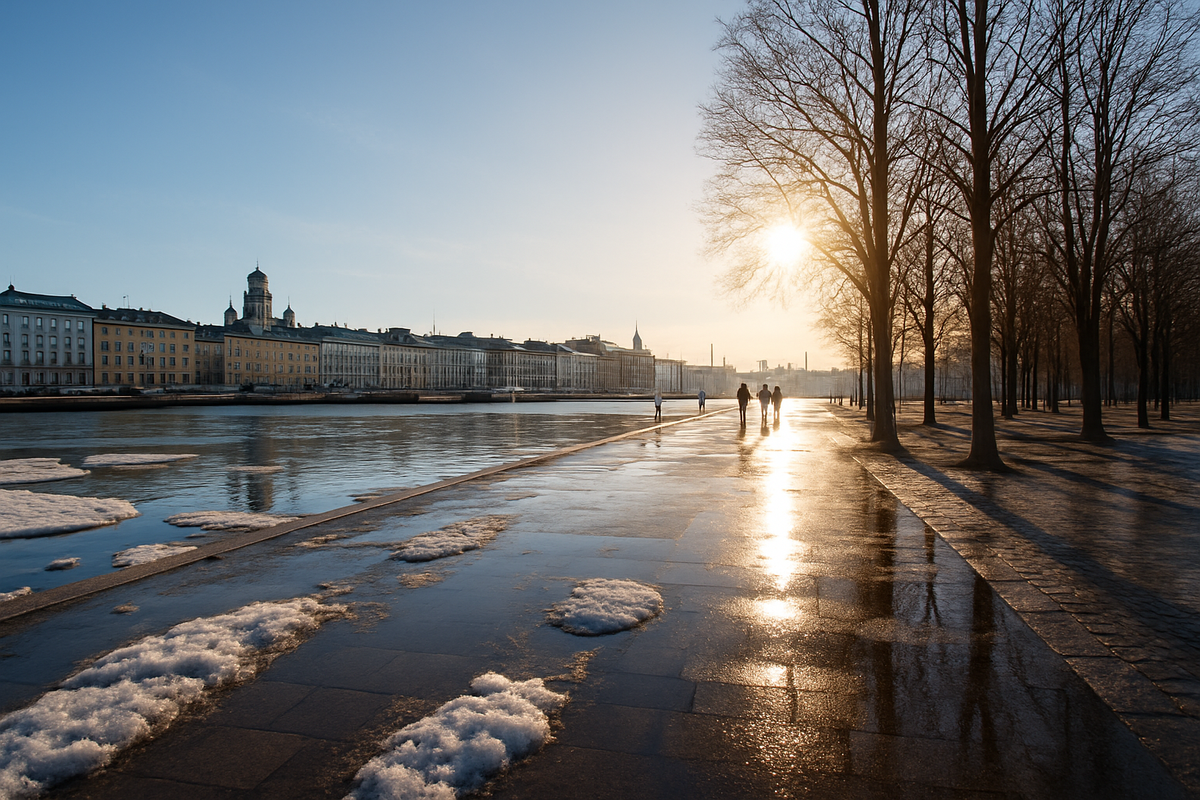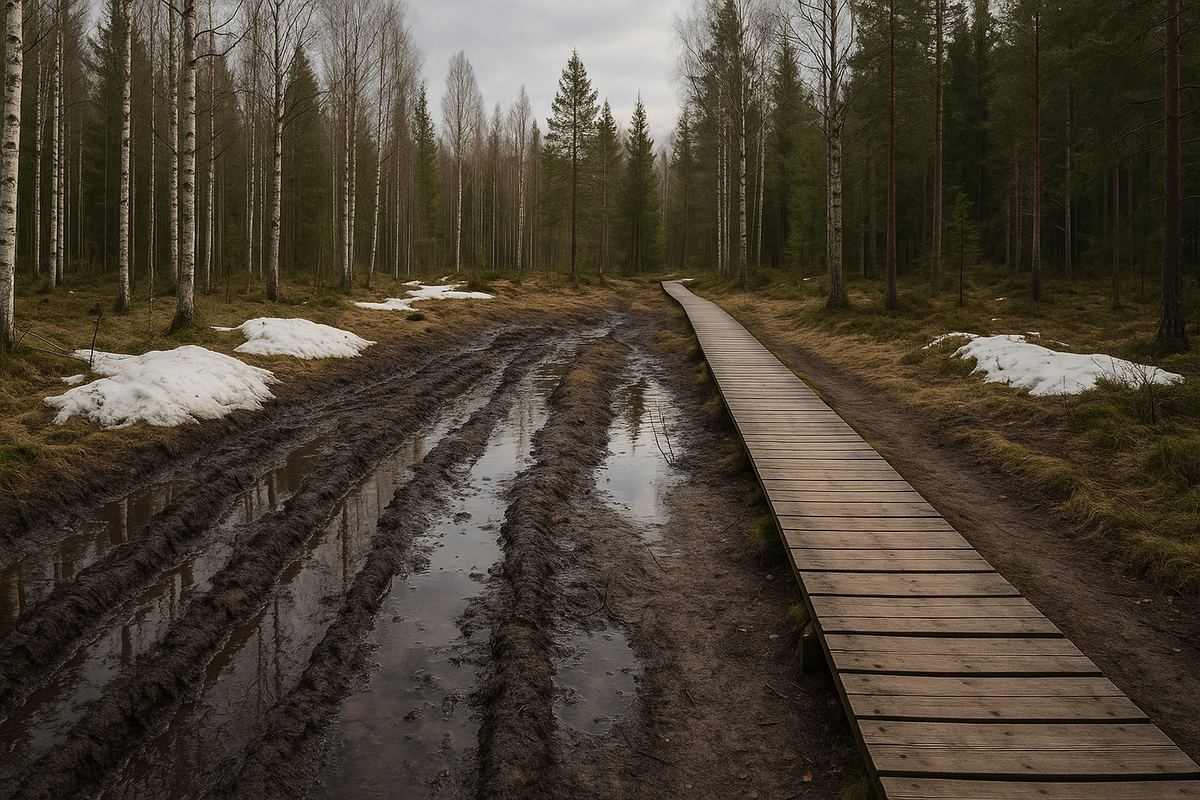🌱 Spring in Finland: thaw, kelirikko and long days
Spring in Finland is absolutely amazing! The days are getting longer, the trails are drying up and the ever-changing kelirikko (thaw) makes every route a new adventure. We will let you know exactly when the frost usually lets up and Saimaa and Päijänne open up, how to get through the slush without getting your knees dirty — by choosing the boardwalks in Nuuksio, taking short loops by the sea in Helsinki and enjoying the first safe kayaking trips in sheltered bays. Get ready for some incredible insights! Inside, you'll discover crystal-clear temperature and precipitation ranges for March to May, expert guidelines for snow and ice melt, a handy clothing capsule, and awesome ideas on where to go right now to make the most of the long days and the wind at your back.
Spring by region: what to expect (March–May)

🌱 When does spring arrive in Finland and how does daylight change?
The first consistently warm days of the year are usually in late March or April, which is great news for those of us in the south. And for those of you in the north, the first warm days are in April or May – so not long to wait! The length of the day increases rapidly: in Helsinki, from around 12 hours at the end of March to around 17 hours at the end of May; in Rovaniemi, from around 11 to around 18 hours. The best time to get out and about is during the day and early evening, when there's more light, it's warmer and safer for travelling. The great thing about April is that you can still get night frosts, so you can get those early starts!
🧊 When do Lakes Saimaa and Päijänne "open up" and is it safe to go out on the ice in spring?
You know how it is, the usual ice break-up window for the southern lakes is late April to May, and for the northern lakes, it's May and later. When the ice is thawing, it can be a bit unpredictable, but that's all part of the fun! You might find gullies at the mouths of rivers and streams, and there might be changes in thickness near the shore. The rule is really simple: no "wild" outings – only officially open routes where the municipality updates the status. When it comes to skating and walking in spring, I would highly recommend checking out the boardwalks and dry forest trails – they're just perfect for those leisurely strolls. And once the weather has stabilised, why not try your hand at SUP or kayaking in some secluded, sheltered bays?
🚶 What is kelirikko and how to plan routes during the thaw?
Kelirikko is slush: roads and trails soften after thaws, and some boardwalks and crossings are temporarily closed. When you're planning your route in Nuuksio, Repovesi and Koli parks, it's best to think of it as a short adventure (1-3 hours) where you'll be returning to familiar ground. When you're out on the boardwalk, it's a good idea to wear shoes with good grip. The wood can get a bit slippery after it's rained, so you'll be thankful for that! Hey, just a heads-up: it's always good to have a "plan B" ready, you know? Like maybe a museum/sauna/cafe in the city, or even some lovely trips to the forest in the morning when the wind is gently drying things out.

🥾 When do the "first trails" open and what should a beginner choose?
In the south and in the Lake District, you might be lucky enough to spot the first dry areas as early as April in windy weather. But, of course, it really depends on the exposure and the surface. Keep your eyes peeled for those beautiful loops with boardwalks and rocky ridges: If you're looking for a gentle stroll, why not try Nuuksio (Haukkalampi), where you can take in beautiful panoramic views? Or if you're after something a bit more adventurous, there are some great short routes in Sipoonkorpi that are perfect for those who like a bit of a challenge. It's always best to avoid the marshy lowlands after heavy rains, as they can be muddy and have more mosquitoes later on. When you're just starting out, it's best to keep your distance to around 5–8 km and remember to take poles. They're super helpful on descents in spring!
🌉 How do footbridges and boardwalks behave in spring, and where are there more crossings?
After the thaw, our lovely wooden decking soaks up water and can get a bit slippery, so it's best to be careful. The rain washes away some of the wood, so it's important to keep an eye on it. In popular parks like Nuuksio, Sipoonkorpi and Koli, there are times when sections are closed for repairs or drying. Don't worry, though, because there are signs at the entrances and the status is published online. Why not have some fun and plan some lovely detours and short "carousels" around those highway car parks? If you're bringing kids, it's a good idea to pack waterproof trousers, spare socks and thin gloves. Even if it's a dry trail, puddles can easily appear on turns.
🌊 When does the kayaking/SUP season start and what weather is comfortable?
In the sheltered bays of Saimaa and the Turku archipelago, experienced kayakers start the season as early as April in calm and sunny weather, but for families, May is more comfortable and the water is warmer. Here are some handy wind guidelines for you:
For those of you just starting out, you'll be happy to hear that speeds of up to 4-5 metres per second in closed channels are perfectly fine. But if you're facing speeds of 6-8 metres per second, it might be better to wait a little longer. The water is still chilly, so it's best to wrap up warmly in a neoprene or dry suit, pop on a life jacket, and keep a hot drink in a thermos. When you're planning your trip, it's always a good idea to go in the morning when the weather is more likely to be calm.

🪵 How does spring weather affect prices and availability of accommodation/tours?
March to early April is a lovely time to visit a city, because it's quieter and cheaper than in July. And if you're into winter sports, you'll be pleased to know that Lapland is still very busy until the end of March. Hey, just a heads-up: as we head into May, things start to really heat up with all those city weekends and island trips. But don't worry, there's still plenty of time to get your hands on some amazing deals and find easy parking. This is the perfect time to plan your getaway! Water excursions and husky centres are usually pretty flexible, but it's always a good idea to check the day before, just in case the weather decides to play tricks on us.
🦟 Do mosquitoes appear in spring and where are there fewer of them?
The first mosquitoes usually arrive towards the end of May in the wooded and humid areas of the Lake District and Kuusamo, but don't worry, we're here to help you! You'll find fewer of them on the coast, in open ridges and on windy islands. Here are some simple steps you can take to help prevent mosquito bites:
- Wear a light long-sleeved jacket
- Apply repellent
- Choose campsites away from stagnant water If you're travelling with little ones, you might find it helpful to put a net on the pram and pack some bite relief in your backpack. On windy days, the problem almost disappears, even in forest areas.
What to take in spring: dry, warm, safe
Safety and logistics
When spring comes around, it's a good idea to plan your driving and long journeys during the day, as it's possible that temperatures might drop to below zero at night, and there could be black ice. When you're on the water, it's a good idea to keep an eye on the wind (in metres per second) and how much it's raining. For those just starting out, speeds of 4–5 metres per second and no thunderstorms are a nice balance. When you're out on the trails, it's always a good idea to take care of your knees. Walking sticks and shoes with good treads can really help to reduce the risks. When you're out and about in the parks, please be aware that bridges and walkways might be closed temporarily for your safety, so let's all do our best to respect these closures. The sun is already shining, so remember to wear your sunglasses and SPF cream when you're out on the water or on the snow. The snow is still lying in the shade in Lapland, so don't forget to protect your skin!
Please feel free to share your thoughts in the comments below. If you have any interesting photos, personal experiences or questions about the topic of the article, please feel free to leave a comment. We'll absolutely get back to you, because we're making the most useful and popular blog about Finland!
FAQ — frequently asked questions
Late April and May: longer daylight hours, warmer days (+10...+16 °C), less slush. The weather in the archipelago is windy — choose sheltered bays.
As a rule, no. During the thaw, the ice is uneven and dangerous. Only walk on officially open routes — check the status on the day of your trip.
Loops along boardwalks and stone ridges: Nuuksio, Koli, Sipoonkorpi. Bring waterproof trousers and walking sticks.
Experienced paddlers can start in April when the weather is calm and sunny; for a comfortable family outing, May is best. Beginners should stick to winds of up to 4–5 m/s and choose narrow straits.
The first peak is closer to the end of May in wooded, humid areas. There are fewer on the coast and in windy areas
Yes. On the water and on late snow in Lapland, reflection intensifies UV rays — sunglasses and SPF 30–50 are a must.
Follow the detour signs or change your location: in spring, closures are necessary to prevent damage to the boardwalks and injuries to people.
During storms and heavy rain, island ferry schedules change; roads may be softened in kelirikko. Keep a flexible ticket and allow extra time.





0 comments
Log in to leave a comment